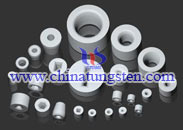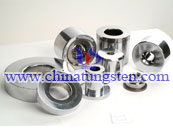Cemented Carbide Drawing Dies
Cemented carbide is a class of material widely used in drawing dies because of their superior strength, toughness and wear resistance.Cemented carbide drawing dies are dies maily used to draw metal wires such as black wire, nonferrous metal wires, rods and various tubes.All major wires ,rods and tubes producers can use cemented carbide drawing dies which include wire drawing dies, tube drawing dies, bar drawing dies.
The application of carbide drawing dies
Cemented carbide drawing dies have a wide range of uses, such as electronic devices, radar, television, instruments and spaceflight high-precision silk material; and common tungsten, molybdenum wire, stainless steel wire, cable wire and various wires. Cemented carbide drawing dies is a kind of very important and easy debilitating mold to all sorts of metal wire manufacturer(such as electrode welding wire, wire factory etc). The drawing dies are very extensive molds and mainly used for drawing bar, wire, silk material and pipe materials for linear difficult-to-machine objects, steel, copper, tungsten, molybdenum, etc.; and metal and alloy material drawing processing.
| Cemented Carbide Drawing Dies | |
 |
 |
| Cemented carbide drawing dies have a lot of applications, such as drawing bar, wire, silk material and pipe materials. | |
How selection carbide drawing dies?
Although wiredrawing molds can be used for processing all kinds of steel, copper, tungsten, molybdenum, etc. metal and alloy materials, but each drawing die has its applicable machining scope, therefore,selecting drawing material is of importance to ensure successful application to obtain the longest die longevity. Different wiredrawing mold all have its relatively reasonable processing objects.
According to the material, drawing molds can be divided into alloy steel, hard alloy mould, natural diamond die, polycrystalline diamond mold, CVD diamond die and ceramic molds and so on. With strong abrasion resistance and long service life, they are widely used in electronic devices, radar, television, instruments and aerospace and other high-tech industries.
For example, in the drawing of copper wire with the same diameter,the service life of polycrystalline diamond die is 300 to 500 times longer than hard alloy die; when drawing nickel wire ,the service life of polycrystalline diamond die is only 80 ~ 100 times, drawing molybdenum wire, the service life of polycrystalline diamond die is 50 ~ 80 times longer than hard alloy die, and pull out carbon steel, the service life of polycrystalline diamond die is 20 ~ 60 times longer than hard alloy die.
The friction problems generally can be divided into destruction and wear. The drawing dies damage can be divided into ring damage, stretching damage, shear failure and bearing surface damage, etc. Friction and wear can be divided into abrasion wear, friction wear and corrosion wear, bruises and fine particles produce wear, etc.
The above several damage and friction and wear form may often be intertwined. But overall, the wear resistance of drawing dies of various materials from high to low ranking is: diamond wiredrawing diess (not consider natural diamond anisotropic problem) - ceramic wiredrawing dies - hard alloy wire drawing dies.
Grades and properties of carbide drawing dies
| Grade | Density(g/cm³) | Hardness(HRA) | TRS(MPa) | Applications recommended |
| YG6X | 14.95 | 91.5 | 1800 | For drawing steel and nonferrous wires or bars of less than Dia.6.00mm under not so much stress. |
| YG6 | 14.95 | 90.5 | 1900 | For drawing steel, nonferrous alloy bars of less than Dia.20.00mm under more stress and also for drawing tubes of less than Dia.10.00mm. |
| YG8 | 14.8 | 89.5 | 2200 | For drawing steel and nonferrous bars and tubes, also for manufacturing mechanical parts, tools and wear parts. |
| YG10 | 14.5 | 88.5 | 2400 | |
| YG15 | 14.0 | 87.0 | 2800 | For drawing steel bars and tubes with a high reduction rate and for manufacturing anvils, drilling and punching and impacting. |
Drawing dies Grades and Performance
Drawing dies Application
Drawing dies Use
Drawing dies Notice






 sales@chinatungsten.com
sales@chinatungsten.com